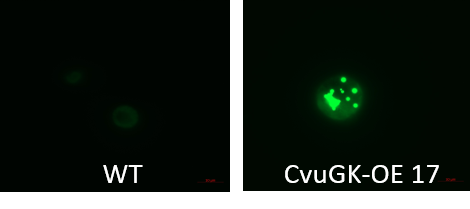Analysis of Human Thyroid Cancer-1 and Annexin V as pro-survival cDNA sequences in Saccharomyces cerevisiaeOverexpressing a mouse Bax cDNA in yeast cells induces cell death. When heterologously expressed in yeast cells overexpression of a mouse cDNA encoding Bax, human Thyroid Cancer-1 (TC-1) or annexin V (ANXA5) suppresses the Bax induced cell death. My goal was to characterize the anti-Programmed Cell Death (anti-PCD) potential of these human cDNA sequences. In addition to rescuing Bax-expressing cells, I found that TC-1 and ANXA5 are pro-survival sequences that protect yeast from other death-inducing stresses including copper sulfate. TC-1 also prevented the deleterious effects caused by over-expression of a number of endogenous yeast pro-apoptotic sequences, including the YCA1 encoded metacaspase; the YBH3 encoded Bcl-2 Homology domain 3 protein, the NUC1 encoded DNase, as well as the apoptosis-inducing factor encoded by AIF1. Even though the protective effects were more pronounced in rescued cells over-expressing YBH3 and YCA1, TC-1 could still protect yeast mutant strains lacking YBH3 and YCA1 from the growth inhibitory effects of copper sulfate. Our results demonstrate that TC-1 and ANXA5 are pro-survival sequences that are able to attenuate stress-induced programmed cell death. 10:30-11:30 BioSci Rm. 3110Illuminating Alzheimer’s with Glow-in-the-Dark Worms Insulin is a key hormone in the regulation of blood glucose levels in many animals. Dysfunctional insulin signaling is one of the most studied and widely accepted theories in the pathogenesis of diabetes and Alzheimer’s disease (AD). Despite the claim of a link between diabetes and AD, the results in the literature have been incongruent. Some studies have claimed that insulin resistance is a major implication in AD, while others have reported that the risk is increased by excess insulin in the blood. Using the microscopic worm, Caenorhabditis elegans, we have developed a model to study the link between insulin signaling and AD pathologies, including changes in neuronal morphology and abnormal behaviour. Furthermore, we have examined the effects of hyperactive insulin signaling on the expression of the two characteristic proteins of AD, amyloid-beta and tau. By genetically modifying the key players of the insulin signaling pathway and the 40 insulin-like peptides in C. elegans, we may be able to identify novel targets for the prevention or treatment of AD. In this research, we tested whether the 40 insulin-like peptides are inhibitors or activators of the insulin signaling pathway, based on the aforementioned phenotypes associated with AD. Alternatively, some of these 40 insulin-like peptides may work through the non-canonical insulin-signaling pathway, with the potential of pointing us to novel genetic interactors. My work has shown that of the 40 insulin-like peptides, some exacerbated AD-like phenotypes, while others reduced them. Understanding the function of the components of the insulin-signaling pathway and the 40 insulin-like peptides in C. elegans may clarify the link between defective insulin signaling and AD and present novel treatment strategies for the disease. 11:30-12:30 BioSci Rm. 3110Wednesday May 16 // Ana Ramos // PhD Candidate, Regan LabMicroalgae cultivation on wastewater and genetic modifications to increase triacylglycerol productionMicroalgae are photosynthetic microorganisms that can grow in a variety of environments. They have become a popular feedstock for the production of biofuels, high-value chemicals, and nutraceuticals. One of the main products obtained from microalgae is biodiesel: a mix of fatty acid methyl esters (FAMEs) obtained from the transesterification of triacylglycerol (TAG). However, microalgal biodiesel still cannot compete economically with petroleoum diesel. Therefore, the objective of this thesis was to explore alternatives to make microalgal cultivation for biodiesel more efficient. Microalgal treatment of municipal wastewater has been discussed as a strategy for the simultaneous removal of excess nutrients and the generation of microalgal biomass. This thesis evaluated the performance of Scenedesmus sp. and Chlorella sorokiniana in the removal of nutrients from non-sterile, highly concentrated synthetic-wastewater. These microalgae removed up to 60% NH4+ and 44% PO43- in a semi-continuous cultivation mode without negatively affecting effluent quality, demonstrating that microalgal growth can be coupled with wastewater treatment. Microalgal research is growing, but reliable genetic transformation protocols are still not available for many species. Such is the case of Chlorella vulgaris, whose transformation protocol has not been efficiently replicated. Therefore, work with the model Chlamydomonas reinhardtii is a practical alternative for proof-of-concept studies. The work in this thesis generated 5 Chlorella vulgaris starch mutants through UV-mutagenesis, and 4 Chlamydomonas reinhardtii transgenic lines overexpressing Chlorella vulgaris genes involved in glycerolipid metabolism. Starch-less mutant st27 produced up to 3.8-fold increase in TAG, while the transgenic lines increased more than 100-fold. Results from the starch-less mutants illustrate the importance of the organic carbon source in the medium to provide enough carbon precursors for TAG biosynthesis. Similarly, the increases in TAG content of the transgenic lines suggest that increasing glycerol-3-phosphate is crucial to generate oleaginous crops. This thesis illustrates the possibility of generating microalgal strains rich in both starch and TAG, which would be a promising feedstock to implement in microalgal biorefineries. Additionally, two new gene candidates to improve TAG yields in microalgal strains are suggested, expanding on the knowledge available for metabolic engineering of microalgal crops for biodiesel production. 11:30-12:30 BioSci Rm. 3110 |
Archives
February 2021
|




